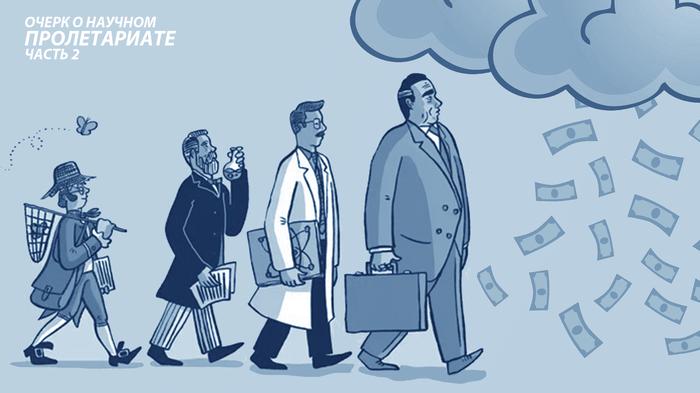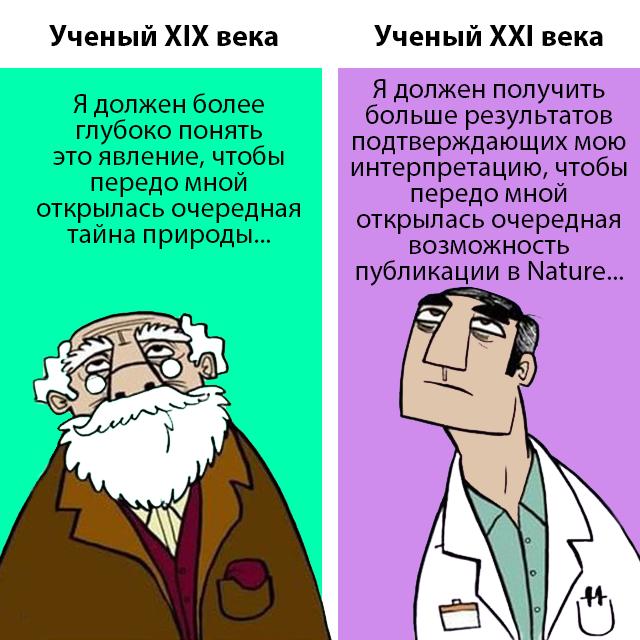
The alienation of the product of scientific work
A commodity under capitalism is not only the working power of the scientist, but the product of his labor, in our case information. In the scientific world the most common form of expression of new knowledge is the scientific article. It was invented in the XVII century to replace pundits personal communication. Under capitalism, the scientific article becomes a commodity that pays either its consumer or the manufacturer for free use for others.

The magazine business is experiencing its heyday in the second half of the twentieth century. The rapid development of science naturally led to the fact that publishers took control of energetic entrepreneurs, trade of access to scientific knowledge has become a very profitable business, the market quickly monopolized. Largest Elsevier capitalization exceeds the Sberbank of Russia. In the digital age monopolists were able to reduce the price of expenses, but much to inflate the price of the subscription. Most of their clients is the University library, which simply has no choice: otherwise employees of the University will be left without information. The following quote from the article London the writer, a former immunologist Stephen’s Burani published in the newspaper “The Guardian”, perfectly describes the business model of monopolies in the publishing business, such as Elsevier, Springer, Wiley, Informa.
“The core activities of the publishing house Elsevier are scientific journals, weekly or monthly publications, in which scientists share with each other the results of their work. Despite the narrow audience, scholarly periodicals — business is quite impressive proportions. With more than 19 billion pounds of total world income, it is for its size occupies an intermediate position somewhere between the recording industry and the film industry, the truth is much more profitability. In 2010, the Department of scientific publications of Elsevier reported revenue of 724 million pounds, obtained with only two billion in sales. This was a 36 percent difference is higher than registered in the same year, such companies as Apple, Google or Amazon.
However the business model of Elsevier was seriously puzzled. To earn money, a traditional publisher, say magazine must cover the many expenses: pays authors for the articles; enlists the aid of editors for the preparation, execution and verification of articles; pays for the distribution of the finished product among the subscribers and retailers. Everything is expensive and the magazines usually get about 12-15 percent profit.
A way to make scientific articles looks very similar — except for the fact that scientific publishers are able to avoid most of the actual costs. Scientists themselves lead the creation of their work — mainly getting government funding — and provide them to publishers for free. The publisher pays the scientific editors, who evaluate whether the work is published, and check her grammar, but the main part of the drafting load — checking the scientific credibility and evaluation of experiments, a process known as peer review — falls on the shoulders of scientists working on a voluntary basis. Then the publishers sell the product institutional and University libraries, again funded by the government, to be read by scientists — which in the collective sense they themselves are the creators of this product.” [11]
Such blatant parasitism and robbery has caused indignation not only of scientists. In 2011, the British journalist and political activist George Monbiot published an article “Landowners in science,” to quote from there:
“You may not like what Rupert Murdoch will charge £ 1 for daily access to Newspapers Times and Sunday Times. But you at least can a day to read and download as many articles. Reading one publishing Elsevier is 31.5 dollar. The Springer takes almost 35 euros for the article, Wiley-Blackwell — $ 42. Want to read ten and ten times pay. And these journals retain the copyright forever. Want to read the old publication 1981? Pay $ 31 50 cents.” [12]
The Russian market of scientific publications monopolized by the publishing holding company Pleiades Publishing, owned by Alexander Shustorovich. The company publishes a large part of the English language versions of articles ran with the participation of Springer Nature. Russian edition published by Nauka publishing house also owned by him.
An alternative model is the model of open access, which started its life in the digital age. You must pay publisher for all costs associated with reviewing and editing the publication, and for this your article will be available free on the Internet. For open-access journals have different business models, in some cases, for publishing pays the author, and the journal is subsidized by the University or exists even at the expense of advertising. The advantage of this model is only apparent: too much competition for publication in a prestigious journal, but flourished “shadow” journals that will publish anything for your money.
Suppose you want to find your opening to know more people. Then you need to send the article to a prestigious journal, which is often cited, which has a higher rating. It is determined by impact factor – a parameter determining the frequency of citation of the journal for a period of three years. The calculation of this figure holds the American Corporation Thompson Reuters. And if initially this indicator was used in bibliometry, in the last three decades, he has become a sort of measure of the prestige of the journal. In vysokooktanovyj journal do not break as easily. You can of course publish in your native country in your native language, but parochial magazine may not be counted in Web of Science, owned by Thompson Reuters and of your discovery can simply not learn.
The fact of the publication of the article, the order in the list of authors and the rating of the journal where it is published, allows the capitalist to assess the scientific productivity of the employee without recourse to its content, extremely formally. And if 40-50 years ago a scientist was able to spend a lot of time on painstaking study of any problem, but now the determining factor is the “rate the rating” of publications. For this reason, as in the case of grant, the publication becomes an end in itself, replacing the original, the real purpose of scientific work. Of course, blatant pseudoscience in a prestigious journal is not published (review-then the scientists themselves), but the focus on quantity leads to an inevitable loss of quality and the safe, risk-free problems, which are little significant for the companies, but the results for them are guaranteed to publish. Levins and Lewontin note that a significant portion of the huge amount of publications today is a noise explosion.

Another defect caused by the system of “Publish or Perish” (publicise or die) is a growing non-reproducibility of the results. This is especially true for biomedical research, because the format of a scientific article does not allow accurate to describe all the details of the experiment. So, you only hear 14% of the results described in the articles on the problem of cancer [13]]. Specific techniques of the experiment can be executed over the years, but in the articles is not taken into account. Results that cannot be reproduced, are not responsible to society any practical use. But increases the likelihood that they will be rigged, even if not consciously. The tragic incident occurred in Japan in 2014: Haruko Obokata, a young researcher from the Institute of biology of development”, RIKEN” published two articles in the journal Nature on a new method of producing pluripotent stem cells. Published the results no one could repeat, including Obokata herself. The articles were removed. PhD Yoshiki Sasai – the unofficial leader and one of the authors of the article – committed suicide, unable to bear the harassment in the press and from the authorities [14].
Publication activity of the scientist tracked using the h – index measure as the frequency of publications and number of citations of the author. Despite criticism from the scientific community, it continues to be used as a measure of productivity of a scientist and hardly will refuse from it. But the above mentioned noise burst will only intensify: to cheat Hirsch index of a researcher is cooperating with several laboratories working on the same problems, after which begins the production of small articles, poor in content, but with reference to respected colleagues. Whether your discovery will bring to society new knowledge – it does not matter. The main thing is to form your work was scientific, but in the meantime you can do an honest cut of grant money and production of information collection.
An inside look
Says Jean, about 30 years, senior research fellow, head of the grant:
“In the rich laboratories, leaders who have good connections and position at the top of the academic hierarchy and foundations that distribute funds for financing scientific work, obtaining grants is often put on stream, and ordinary employees are not burdened with the problem of getting a livelihood and work in the extent to which this burden presses on a small group or lab that does not have their “steam train”. For them, the burden lies with the management and sometimes specially hired secretaries managers to deal with the grant paperwork. In small groups, do not have any links at the top, but where is still a glimmer of enthusiasm and desire to do science, all employees are busy, outside of work, writing applications for grants on different subjects from different funds, which often are sent in parallel, for example, by the Russian Science Foundation (RNF) and the Russian Foundation for basic Research (RFBR). A very small probability of winning in the contest “without handicap” are trying to increase the number of “shots” – of ten shots, nine are in the milk, but once there, he will hit the target. No exception was our group that had applied for grants for two different topics in RFBR and RF. Application to RFBR passed, and in the RSF was rejected. A year slightly redesigned the application again filed in the RSF, but because I’ve already had a grant from RFBR, and also invited me to a parallel project in another lab, the prospect to shoulder the leadership of the third project rather frightened, and was not pleased. But Murphy’s law don’t be fooled – the application of the RSF approved when this is not very desirable. And I became the proud head of his first and immediately quite a large project.
Many will say that to complain, because not everyone gets so lucky to be in several grants, and even lead such a major project at such a young age. Of course, it is, on the one hand. On the other hand, the guide own RSF project has its drawbacks, which sometimes far outweigh the advantages. To be the leader grant is not only the development of their topic and science work as a constant, permanent solution to any issues that are good, to decide not you, but specially trained people. And this is all in addition to what is needed in parallel to conduct a very intensive research activity, because of the RSF, out of their “clients” all the juice, requiring 10 or more publications in three years.
Planning and Finance Department (PFD) and accounting
With a limited staff and a relatively large reporting burden on the part of the Directorate are forced to distance themselves from level performers and his problems. The advantage here is the simple desire to shift as much of the unpleasant work to others. As a result, the work on registration of contracts with suppliers and contracts with artists, preparation of cost estimates, resolution of disputes with companies, paperwork, tracking shipments, accounting rests on the shoulders of the project Manager. I sometimes had to be coaxed out of the staff of PFO banal samples of agreements made in the previous time, and sometimes asking more experienced colleagues to talk with PFO, because at my request there was no response. In addition to all this, because of the General chaos PFO often loses the documents that you have sent him, forcing meticulously, almost to paranoia to check the number of sheets and copies of all papers, because all the buds will eventually get the grant administrator. Especially pleasing situation when a week tormoshat reportchicago Manager of the company who have forgotten to send you the correct piece of paper (according to PFO), he’ll eventually makes and sends, and the next day the employee PFO solemnly finds a lost document in a pile of their securities. Not less pleased with the situation, when employees of the PFO charge you that you do not have how to pay your purchase bills. Example: contract with a firm 30% advance payment was made and endorsed by all parties, 30% down payment paid. After delivery of the reagents the staff of Volga Federal district mistakenly sent documents to pay 100% of the bill that led to the overpayment 30% of the amount. Manager of the firm reports it, I call PFO and figure out what it is, I had to write them “a pencil on the memo” that you need to pay 70% of the amount, although the document was supposed to be them. In the end, again, blame the project Manager, but not administration.
In addition, PFO is a hostage of the Directorate, which is in violation of the terms of the funds requires garantodateley to deduct the overhead expenses of the organization instead of 10% all 15% or 20% of the grant amount, that the proper interest of regulatory authorities could lead to criminal charges. However, with some of the murky maneuvers the overpayment disguised fake invoices for purchases – it turns out that I would buy it for 250 thousand RUB additional supplies and not give them to organizations just. Of course, no actual purchases will not occur. The Directorate is motivated by the fact that, say, the Institute did not have enough money to make ends meet. There was a funny moment when I came to one respected person, also leader of the project, with a question – how to be in this situation and is it possible to somehow reason with the administration? What he told me that when he announced about this decision, it was a lot of indignant statements from the heads of grants, up to threatening to leave in droves to other institutions. Of course, it all ended in nothing and quite fast: a particularly violent lucidly explained that no one holds, they can go on all four sides right now, and the fighting spirit of the protesters quickly faded. On the question of how ready someone is to unite to resist such extortion, a respected man replied that indeed, everything seems on the one hand and want but can not. In short – shut up and suffer. That is, about any Association of garantodateley and their collective struggle against abuses by management no question: project managers holding on like a lifeline for their grants and places and are willing to tolerate, apparently, any infringement in order to preserve their status.
Workload
Work on the RSF grant obliges to report a large number of publications, so in addition to overcoming endless bureaucratic red-tape leader must actually do what it is the grant received and research work, its organization, planning, conducting experiments, processing of results and writing articles. For reporting on the RSF project requires a minimum of 10 articles over three years, i.e. at least 3-4 articles a year, and very welcome publication of the results in prestigious (read: foreign) top journals. Accordingly, in order to fulfill the requirement of the Fund, to conduct research in a very tight, busy schedule. Thus, increasing the duration of the working day: on average, I spent 10 hours working time per day (excluding lunch and time in transport on the way to work with it). That is, the variation goes from 8 up to 12-13 hours a day depending on the need. If we add to this the time for lunch and transport, respectively, the numbers increased from 10 to 15 hours a day. Of course, when working in such a furious pace about any leisure, Hobbies or just the rest of the question: having come home, you just want to turn off the brain and doing nothing. For example, if earlier, after work I could go in the evening to the girl, but now such opportunities are often just not there. At the weekend at least one day is spent on it just to sleep and relax at home, not going out, unless to the shop to buy necessary goods. Sunday somewhere to go and something to do also want not always because of forces you just don’t have anything. The maximum that I want to watch a movie or to hang out on YouTube. Of course – this is only my individual characteristics, but I think not many people have the time and energy to something more. Besides, at the weekend, have to finish the house that did not have time to do in a laboratory to read the literature, process the data, make plans for future work, which essentially takes away the time dedicated to rest. Some trips, excursions and travel have got the perspective to be realized only in the vacation, which will be half eaten by the same – preparation of articles, a resolution of bureaucratic issues with the administration and so on. After several months of working like this is coming real exhaustion, which seemed something ephemeral. I used to think that burnout is only peculiar to people in routine occupations, that to me will not happen, but I was wrong. It is very difficult at the end of the year, when added to the effects of weather and lack of sun. Lack of sleep, fatigue, constant nervous tension, dullness on the street have a negative impact on health: I began to be sick, returned cigarette, periodically pulled to drink at the weekend, because it’s easier just to relax and forget for a while about their problems.”
Unfortunately, in our semi-periphery country, the majority of young scientists and graduate students maintain an established relationship. They accept and profess the principle of “publicise or die”, looking for a place of study and jobs not on the basis of his desire to pursue a specific scientific problem, and “success and prospects of the laboratory”. The vast majority generally perceives “nemestrina” directions at least something strange and not deserving of interest and attention. Those who were lucky enough to work in funded labs, are often subjected to the most brutal exploitation: pressure from superiors, work on weekends and holidays. If the academic supervisor no grants or they are small, the young scientist sometimes you have to earn money on the side, as on a miserable fellowship not live. The absence of the grant forces the employee to get part-time in another institution, earn money on the side tutoring. Of course, there are immigrants from affluent families who can afford to do science “for the soul” and not for money. After all, the creative nature of the work and schedule are often very attractive. A significant part of the aims included in the global market and to go to study and work abroad as soon as possible by applying for internships and scholarships. Because the market is saturated, then after graduate school without publications in good journals and good advice from a helpful person to leave is much more complicated. There are those who go to work in the field of trade of scientific equipment or other science-intensive production.
Despite the wide range of political views (through the efforts of our scientific popularizers often liberal), the absurdity of the grant system, the isolation of the work of a scientist from real public needs becomes obvious to a growing number of people. Add to this low pay and paper statements and will receive a quite good ground for doubting the adequacy of the system as a whole. Show that the root of these problems – by themselves capitalist relations, is the task of the agitator is working in a research team. Modest experience tells us that the best way of promotion in this case – individual. In case of success, possible involvement of a person in a sectarian work.
On the way to overcoming
So we have a vicious circle in which the work of a scientist and his products are alienated from himself. The higher the rating of a research worker, the more likely it is to grant with the aim to publish the article for even more cheat rating. And this vicious cycle is fueled by the goal of becoming “freelance scientist” that has the privilege: the opportunity to engage in free scientific creativity, getting enough money from the state. In respect of such class “a successful scientist” is closer to the bourgeoisie than to the proletariat. Usually it deals exclusively with the leading work in its “plant for the production of scientific knowledge.”
The scientific proletariat are very numerous, but to realize their class position prevents him competitive environment in combination with the hierarchy in the scientific community. It is due to my lack of time. As noted by John Tregoning [15], doctor of medicine of Imperial College London, the scientists loaded a side job so that they do not have time to comprehend his situation, as issues dedicated to the common good, seem too vague. As it is, may diminish the opportunity to break out upward, a researcher in the mass, infected with petty-bourgeois ideology of personal success. Criticism of the existing system on the part of prominent representatives of the science is superficial and limited, of course, cosmetic reforms, particularly proposals to improve the system of teaching, talking to graduate students about careers in industry to reduce the crush at the entrance. They give benevolent guidance to funders about how we need to take into account the level of training of the applicant, etc. On the elimination of capitalism from scientific luminaries you will never hear it, because it is the best system that rewards the worthy!
But since there is a proletarianization of scientific worker, insofar increases the possibility of replenishment of the ranks of the revolutionary intelligentsia. That is, scientific knowledge about how to build a new society, will be available no units, not even hundreds of people, but much more of them.
Every scientist should realize that he is being exploited, and that only under socialist public relations he will be able to be fully realized in science. Because the socialization of undergo not only the corporeal means of production, but also information, this means that all articles will be freely available, that would accelerate scientific progress. Perhaps scientific journals thing of the past, because publication requirements are stricter, and check each article will require a large amount of resources. Instead, a special service will load the report on the work done after the evaluation of the workforce in the public domain, and discussed online. These services have already been created with the support of private charitable foundations, such as Open Science Framework. The state-owned workers, will be strongly interested in how to invest in a “losing” branch of science, much more money. Researcher will again become an honorable profession as it was in the USSR, despite all the shortcomings of Soviet science. The efficiency of a scientist will be evaluated by the labor collective and the leadership Institute that will look at the real employment problems and achievements of each person. In the past leaving formal criteria “of publishability” and citing.
But that’s the future! And while it is worth to note that the new social relations, albeit with difficulty, but gaining traction. September 5, 2011 neuroscientist and programmer Alexandra Elbakyan has created a service for Sci-Hub, which allows you to download articles that are in closed access. Sci-Hub has helped and continues to help hundreds of researchers: scientists from the countries of the periphery have gained access to knowledge that was denied due to the fact that their universities could not pay for a subscription to magazines at high monopoly price. According to the site, more than 78000000 articles free. Interestingly, the pirate service widely used in developed countries. Before to download the article from the closed access, you had to go to the library of the University, on the condition that a paid subscription, or to pay money for the article. Now, thanks to Sci-Hub, you can download the article in a few seconds absolutely for free. The new York district court upheld the claim of the company Elsevier and ordered Alexander to pay $ 15 million. The Creator of the project, to make a revolution in the scientific world, concealing his whereabouts.
In conclusion, we note that at the moment, despite the growing popularity of the movement for open access, the awareness of researchers of their social class goes slowly and spontaneously. To help realize it – that is the task of the Communists of the future, to which we have the audacity to classify themselves.
Young scientists
Notes see source
© 2019, paradox. All rights reserved.





